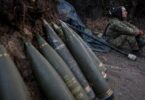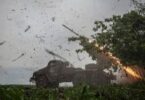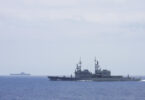ISLAMABAD (Monitoring Desk): In the last few months of the Obama administration, the US state department made an announcement which caused a new breach in Washington’s tumultuous relationship with Pakistan.
John Kirby, then the department’s spokesman, said Congress had decided to approve the sale of eight fighter aircraft to Pakistan.
However, he added that some senior members of Congress “have made clear that they object to using foreign military financing [a form of military aid to help countries buy US weapons] to support it”.
While the announcement garnered little attention in Washington, it was a much bigger deal in Pakistan: by withdrawing financing support, the US had in effect increased the price of the new F-16s from $270m to $700m, putting them out of Islamabad’s reach.
US policymakers were concerned about Pakistan’s perceived failure to tackle domestic extremism, which has had a knock-on effect in Afghanistan, where the US is engaged in its longest overseas war.
But for their counterparts in Islamabad, the incident confirmed what they had believed for a while: the US could no longer be relied on as their armed forces’ primary source of advanced weapons, British daily Financial Times reported on Wednesday .
As a result, Pakistan is focusing instead on the rollout of the next batch of the JF-17, the fighter jet it is developing with China, and which is catching up with the F-16 in terms of capabilities.
One former Pakistani minister recalls telling colleagues the US decision confirmed his worst fears. “We have learnt over time that the Americans are terrible when it comes to honouring their promises,” he says. “This was bound to end up in divorce.”
Pakistan’s response encapsulated what had been a slow but steady shift in military procurement away from American-made weapons towards Chinese ones, or those made domestically with Chinese support.
Since 2010, US weapons exports to Pakistan have plummeted from $1bn to just $21m last year, according to data from the Stockholm International Peace Research Institute.
During the same period, those from China have also fallen, but much more slowly, from $747m to $514m, making China the biggest weapons exporter to its southern neighbour.
The shift coincided with Islamabad’s growing suspicion about the closeness between the US and India, but was accelerated by the killing of al-Qaeda leader Osama bin Laden on Pakistani soil in 2011, which badly damaged relations with the US.
This year, relations deteriorated again when President Donald Trump suspended $2bn of military aid to Pakistan, accusing it of showing “nothing but lies and deceit” in its promises to crack down on the Taliban and affiliated groups. The problem for Mr Trump is that he needs support from Pakistan as he recommits to the war in Afghanistan, and his officials are finding that Islamabad is less responsive than usual to the US message.
Harrison Akins, a research fellow at the Howard H Baker Jr Center for Public Policy at the University of Tennessee, says: “The Trump administration’s decision to pursue sanctions against Pakistan, alongside Trump’s fiery rhetoric can only push Pakistan further into the arms of Beijing — especially with Pakistan’s shift from US military supplies to Chinese military supplies. In the short term, this will make the US mission in Afghanistan more difficult and costly.” For the US, there could be longer-term consequences that stretch well beyond its complicated relationship with Pakistan.
While many countries are just discovering the benefits of Chinese weapons, Pakistan has been buying from Beijing for decades, starting after the US placed an arms embargo on it in the wake of the 1965 war with India.
After that, every time Islamabad has suffered diplomatic problems with Washington supplies of Chinese weapons have risen.
“In the last decade, China has collaborated much more expansively with Pakistan, with the intention of providing its ally with a tactical, military-technical edge,” says Jon Grevatt, an analyst at the defence research company Jane’s IHS Markit.
Examples since 2010 include A-100 rocket launchers, HQ-16 air defence missile systems and VT-4 tanks, which are reportedly now being tested in Pakistan.
But three weapons systems in particular encapsulate the new Chinese capabilities, and the way in which they threaten US influence in south Asia. The first is the JF-17 fighter aircraft.
To understand why Islamabad has been so keen to develop the warplane requires a potted history of the F-16, the American-made jet, and the starring role it has always played in the melodrama of the US-Pakistan relationship.
After sending about 40 of the aircraft to Pakistan in 1983, the US cancelled a second shipment in 1990 because of concerns over Pakistan’s nuclear weapons programme.
The incident triggered fury in Islamabad, not least because Pakistan did not recover the money it had already spent on the aeroplanes — only receiving partial compensation in 1998.
Luckily for them, just as the US was making it more difficult to buy its weapons, Beijing was knocking on the door. If the US thought the F-16 was irreplaceable, it received another unwelcome surprise in September 2015, when satellite images revealed that an attack by Pakistani forces on militants near the Afghan border was carried out by a drone that “strongly resembled” a Chinese design, defence experts said. While surveillance drones are simple enough to build, say military experts, ones with armed capabilities are far less easy to develop.
“Towards the end of the Obama administration, Pakistanis would see drone attacks on their screens every night,” says Sherry Rehman, a former Pakistani ambassador to Washington.
In October 2016, just a month after the US said it would not subsidise the sale of new F-16s, Beijing announced it would sell eight attack submarines to Pakistan for about $5bn — the biggest single arms export deal in the country’s history. The deal is a shot across the American bow because it could enhance Pakistan’s capacity to challenge India in the Indian Ocean. “This is a headache for both the Americans and the Indians,” says Mr Wezeman.
In Islamabad, US officials are engaged in a blizzard of diplomacy as they try to repair the rift between the two countries. “We are not walking away. We have suspended the security assistance, but our channels of communication are open,” says one senior US diplomat. But Pakistanis say they fear relations have hit a historic low. “The Americans are hectoring us in private now; even at the worst times that was not the case,” says one Pakistani official involved in talks with US counterparts. Mr Hussain says: “People are bored with the US — they have given up on the US. Let them stew in their own juice. Forget about them.”
Now Washington’s traditional threat that it will cancel military deals holds less sway. “The problem for Washington is that there will come a time when you run out of levers,” says the Pakistani official. “It is best to keep options and windows open.” If Pakistan shows that Chinese support enables it to resist US demands to do more to assist the war in Afghanistan, it will set an example for other countries. “Arms sales have long been a tool of US foreign policy, to cement alliances and gain influence,” says Mr Wezeman. “Now that Chinese technology is competitive, if American allies start saying they prefer the terms offered by China, that spells trouble for the US.”






